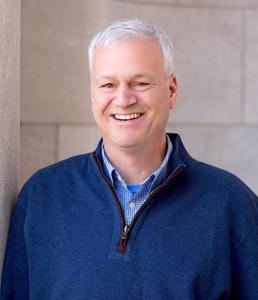 |
|
| Pat Harris (photo: Michael Murrary) |
|
Pat Harris is a lifelong Saint Paulite and passionate community champion. His commitment to public service began in 1989 as a VISTA volunteer at Catholic Charities, where he first learned about the Saint Anthony Residence and heard tales of a softball team that won it all. The experience sparked a lifetime of civic engagement and advocacy. Harris's debut novel, A Season on the Drink (Adventure Publications, September 9, 2025), chronicles the story of Marty Peterson and the Saint Anthony Residence fast-pitch softball team their single, undefeated season, and the flash of inspiration it provided. Harris and his partner, Laura, have four dynamic children, and one enthusiastic canine companion named Ranger.
Tell me about the line between verifiable fact and fiction in this novel based on true history.
It's nearly all true, although obviously you have to bring in some license in order to really show the story. When I was a VISTA volunteer, I spent time at the Saint Anthony Residence and learned some of the struggles that people were going through, but also the hope that existed in that building. It's kind of the end of the road if you're a person in the deep levels of alcoholism; that's where you can go to sort of live out life and continue to be an alcoholic. I spent a lot of time there learning about people, and I heard this story, of this one year where they started playing pickup softball games at this park near the building, and they were kinda good! In the middle of some very intense poverty and alcoholism, they were good softball players. It was anchored by a guy I eventually worked with, Marty Peterson, who played baseball at the University of Minnesota. He was a standout baseball player, but alcoholism turned the tide of his life. As soon as I heard it, I was like, someone's gotta tell this story. A lot of stars aligned to really change some people's lives. The Saint Anthony is a very intense place that a lot of people are unaware of, but this one year, something really cool happened.
I spent the better part of many years interviewing people and learning what happened. I compiled all the information, but I wasn't at the games, so I had to reconstruct them based on interviews and stories. All the members of the team, as far as we can tell, have passed. The staff people have passed. Some of the people in the book are still around.
When Marty got sober and got out of the Saint Anthony Residence, that's when I met him. I discovered this extraordinary person with a trove of original poetry, who saved a child from a burning building (which is in the book)--an absolutely 100% true story that was on the front page of the St. Paul Pioneer Press. My main character, who was a chronic alcoholic and played on this softball team, saved a child from a burning building! You can't make that up. It had to have been true; I could never have thought of it.
What research did you do?
A lot of it was that I was there. Not for the games--that season happened before I arrived--but the stories were told with great pride. I just spent time there and knew everybody. There were extensive interviews. Marty Peterson's son and I have become good friends. He tells some amazing stories about his dad, ones of struggle and ones of extraordinary times. A little baseball research here and there, to correlate to what was happening in baseball at the time. The Twins were on the verge of the World Series--they didn't have a phenomenal season in '86, but they won the World Series in '87.
Is this a book about baseball?
This is a book about hope. The game of softball, or baseball, carried some people on this pathway of hope and of perception. Sure, it's a sports book. But it's also a book about hope and recovery and alcoholism and poverty and all over the top of it, perception. You're a bank, or a construction company, or whatever, and you're playing people who are chronic alcoholics--they're wearing jeans, and they're smoking, and half of them are actively intoxicated, perhaps on Lysol or other chemicals, and they're beating you--badly, sometimes. And competitive juices flow on ball fields, and people get angry. But at the end of these games--hey, you know what, y'all might be at the Saint Anthony Residence, but you're all right.
This book has a little bit of everything. It's got sports, it's got some humor, a lot of sadness, and recovery... and it's got people that couldn't get out of those depths. A lot of the team passed onsite, or somewhere not far after exiting the facility.
It's not singularly a book about sports. It's about perception and hope, in a true story. This is really emotional for me because people matter. People matter. There are a lot of places that lesson can be taught, and one of them is the ballfield.
What about Marty captured your attention so hard?
I was in my 20s when I met him as a client in the job service program. Marty was one of these guys... this softspoken person that had struggled all his life with the disease of alcoholism. At his core, externally and internally, Marty was a brilliant and good human being. He struggled with this disease; it impacted his family, his job, his ability to be successful in baseball. And he was an extraordinary baseball player. He was kind and decent, and we'd sit in the Union Gospel Mission Thrift Store where he worked, and we'd talk about books and about life and where he was going. He was kind. And then I found out he was a poet! You read his poetry, or the letters his son allowed me to see, and it's extremely emotional. The gentleman was deep. And, oh yeah, he saved a child from a burning building! --Julia Kastner

